Zangskar Mystic Land
First published in Sanctuary Asia,
Vol. 24
No. 12,
December 2004
Text and Images By Tsewang Namgail
A cold gust swept across the mountain face as we alighted from our jeep at Chiling, a small village encircled by towering mountains in the Zangskar gorge. British researcher Ashley Spearing and I were setting out on a survey of the elusive snow leopard Uncia uncia and its prey species in the Shun gorge.
We set off along with five hardy porters, a cook and a guide on the thick carapace of ice, locally known as chadar (sheet), that covered the mighty Zangskar river, our gear loaded on improvised sledges made from plastic pipes. The frozen river is a lifeline for Zangskaris for almost seven months of the year, when trekking routes and the only motorable road from Kargil are blocked by heavy snowfall. Our porters set a blistering pace, and it was hard to keep up with them. After a four-hour walk on the frozen river, we sought shelter for the night in a soot-blackened riverbank cave, one of many that dot the route.
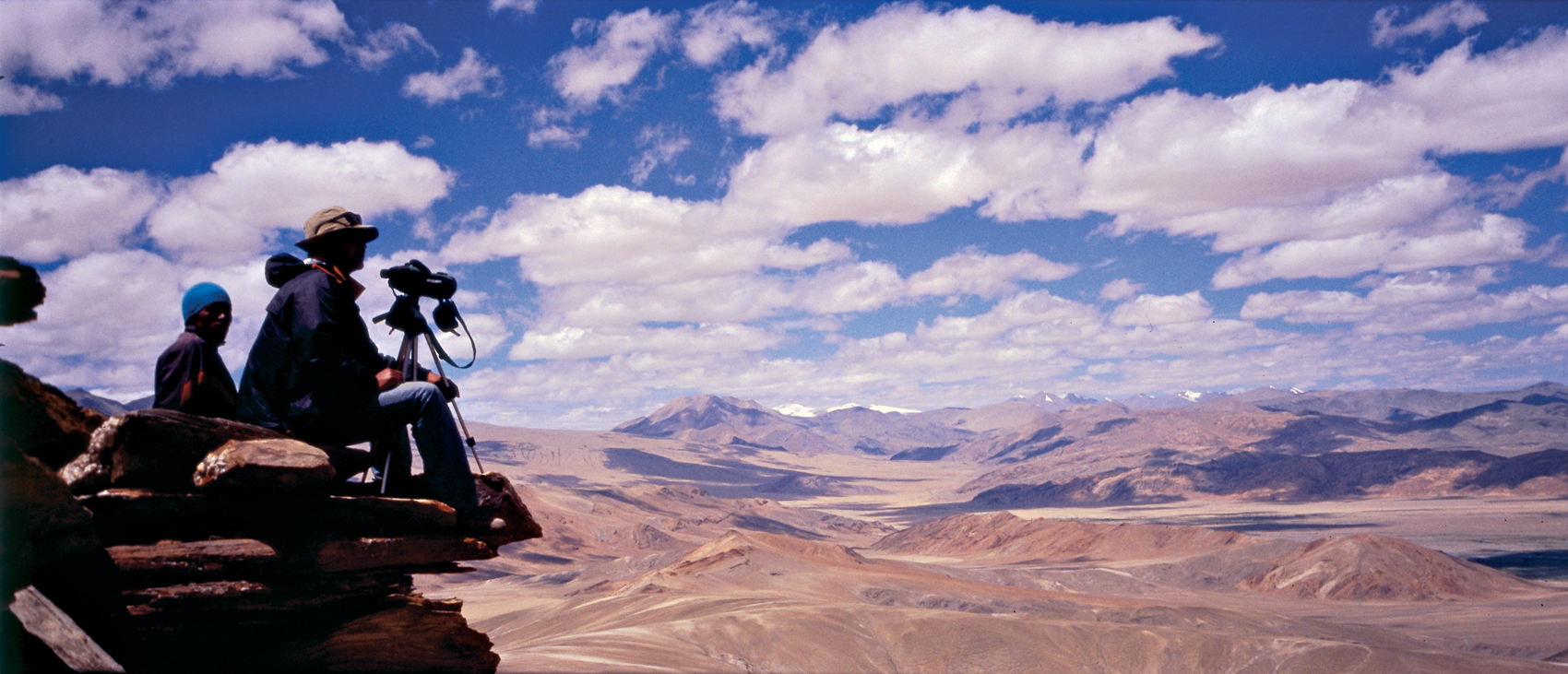
The author and his field assistant scan for wildlife on the Changthang plateau.
The next morning, as the peaks sparkled with the sun’s first rays, we continued up the gorge, struggling for breath in the rarefied air. Around mid-morning, a gimlet-eyed porter spotted a herd of ibex Capra ibex, nibbling on a barren-looking slope partially covered with snow. Through the spotting scope, we could identify three males with their beautiful scimitar-shaped horns, along with two females and a kid. They soon vanished amidst the crevices in the precipitous rock face. Climbing up vertical rock faces is their forte, an evolutionary feat that has to be seen to be believed!
Barren as the mountain slopes seem, there are actually innumerable herbs and small shrubs that the wildlife depend on. Zangskar is known for its herb diversity, many of which have medicinal properties. Traditional Tibetan doctors or amchis visit the area every year to collect herbs.
We walked slowly, surveying the area for snow leopard and other wildlife, stretching a five day trek to seven. Zangskaris normally complete the chadar trek in just three days! We passed a group of sturdy locals walking, would you believe it, barefoot through the slush covering the ice-sheet, to keep their shoes dry, the sharp ice lacerating their feet and tingeing the water with blood. A motorable road will be completed soon and after that only the most adventurous tourist might venture on to the chadar. My concern is that vehicular traffic will restrict the movement of species such as the snow leopard, which use the gorge as a transitory route, as indicated by the tracks, scrapes and spray-marks we saw along the river.
Seven days after setting out from Chiling, we reached Hanumil, a hamlet comprising two stone-and-mud houses, from where we had to catch a bus to Padum, Zangskar’s administrative headquarters. The flat roofs were stacked with bushes and wooden blocks, fuel for the winter. One afternoon, I spotted a deep furrow in the snow on a slope across the valley; apparently left by an animal. But which one, and where was it now? I followed the furrow and came across a huge male ibex, floundering in the snow up towards a rocky outcrop. Seemingly in deep trouble, for the ibex it was just another gamble in the game of life. Species like the ibex survive at these altitudes thanks to their strong legs, which they use to dig through thick snow to uncover buried grasses and herbs.
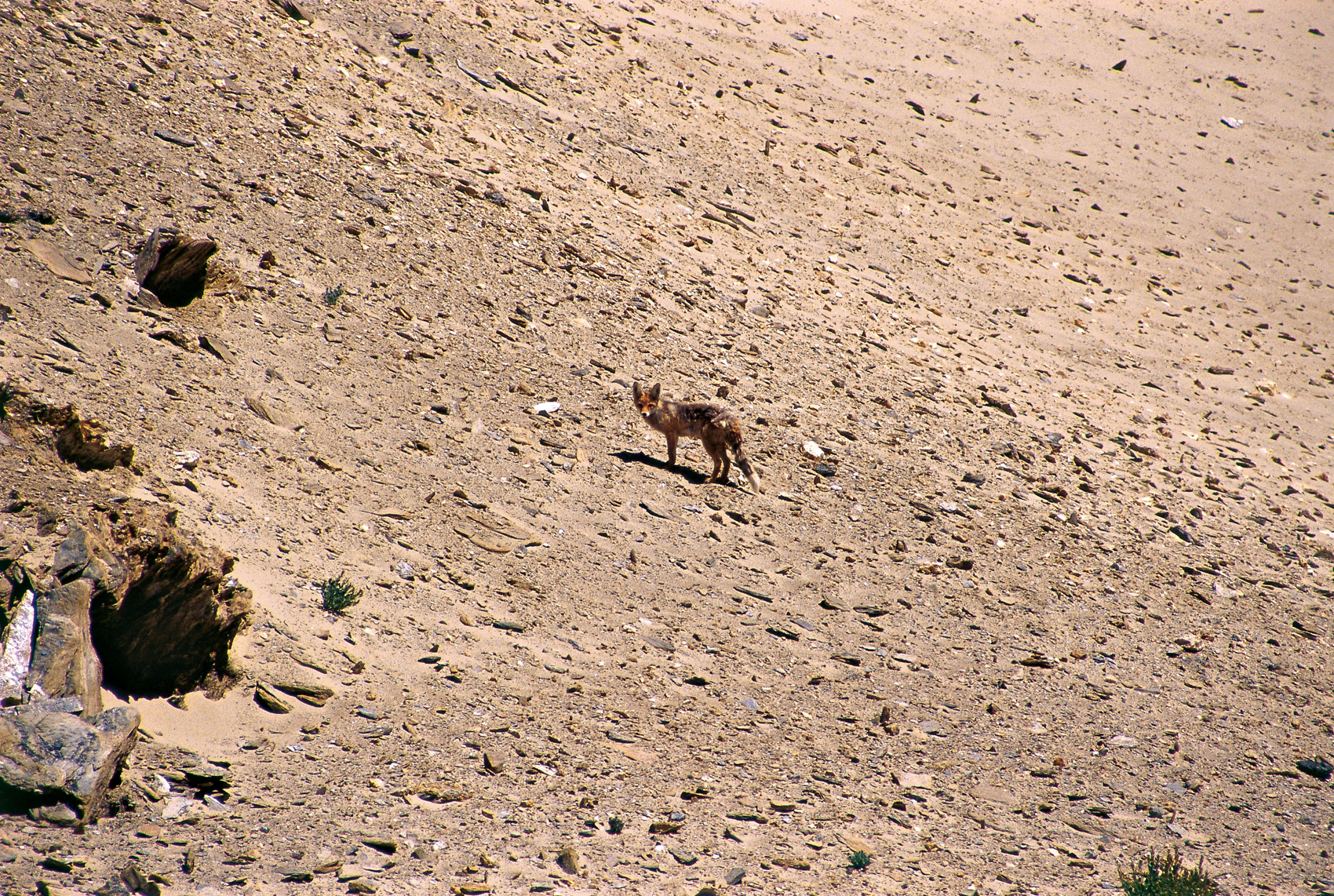
Though the Zangskar mountains might appear barren, they host a surprising diversity of life, including the red fox.
Religious protection
After a three-day wait, a bus arrived from Padum to pick up Zangskari pilgrims returning home after a month’s pilgrimage to Bodh Gaya and other holy Buddhist sites. Talking to the passengers, I learnt of the harmonious co-existence of the monks of the Stongde monastery with herds of bharal Pseudois nayaur. “Nabo gonpe dun la yondug ley” (“Bharal roam fearlessly in the sanctuary of the monastery”), said a pilgrim. I later also heard of ibex using the surroundings of the Karsha monastery to take refuge from predators. The Buddhist code of conduct and ancient monastic regulations have helped protect wildlife, inculcating in people a respect for all life. “Monks impose fines and punish those who hunt or harm wildlife,” said another pilgrim.
Lungnak valley
We halted at Padum for two days before dashing off to Lungnak (meaning dark valley; on account of its black rock formations). Once the capital of the Zangskar rulers, Padum has a population of about 900 and is a convergence point for several trekking routes. Our next stop was Mune village. Around mid-morning, we spotted a huge herd of ibex on a cliff across the Lungnak river, and soon afterwards, the Bardan monastery came into view. Legend has it that in the 16th Century, a raven stole one of the butter lamps, a light offering to the deities, from a monk and placed it on a conch-shaped hillock. Since the conch is an auspicious symbol, the monk sanctified the site for the construction of a monastery.
Darkness came before we could settle down in Mune. Phuntsog, our cook, had gone ahead to arrange our stay. On arrival, we were invited straight into the kitchen. All we could see through the blinding smoke was a kerosene lamp and the flaring yak dung in an open hearth in the centre of the room. The traditional kitchen or chantsa is centrally located and the warmest room in the house. In winter, the entire family eats, drinks and sleeps in this room. Warm as it was, I couldn’t stand the smoke for long. Tea was served in a large room on the top floor, half of which was stuffed with Artemisia bushes, the main fuel source in rural Ladakh.
Almost every village in the Zangskar valley has a monastery, and the Phugtal monastery, which dates from the 11th Century A.D., is one of the most magnificent and holy. It is built in a cavern with the monk’s quarters spilling over a cliff below. In the afternoon, we sat with some young novices, who were unimpressed when we told them about the red fox Vulpes vulpes montana, which we had spotted earlier. They suggested that we keep a lookout in the monastery precincts. Sure enough, we saw three foxes in the evening: a living testimony to the co-existence of man and beast in Zangskar.
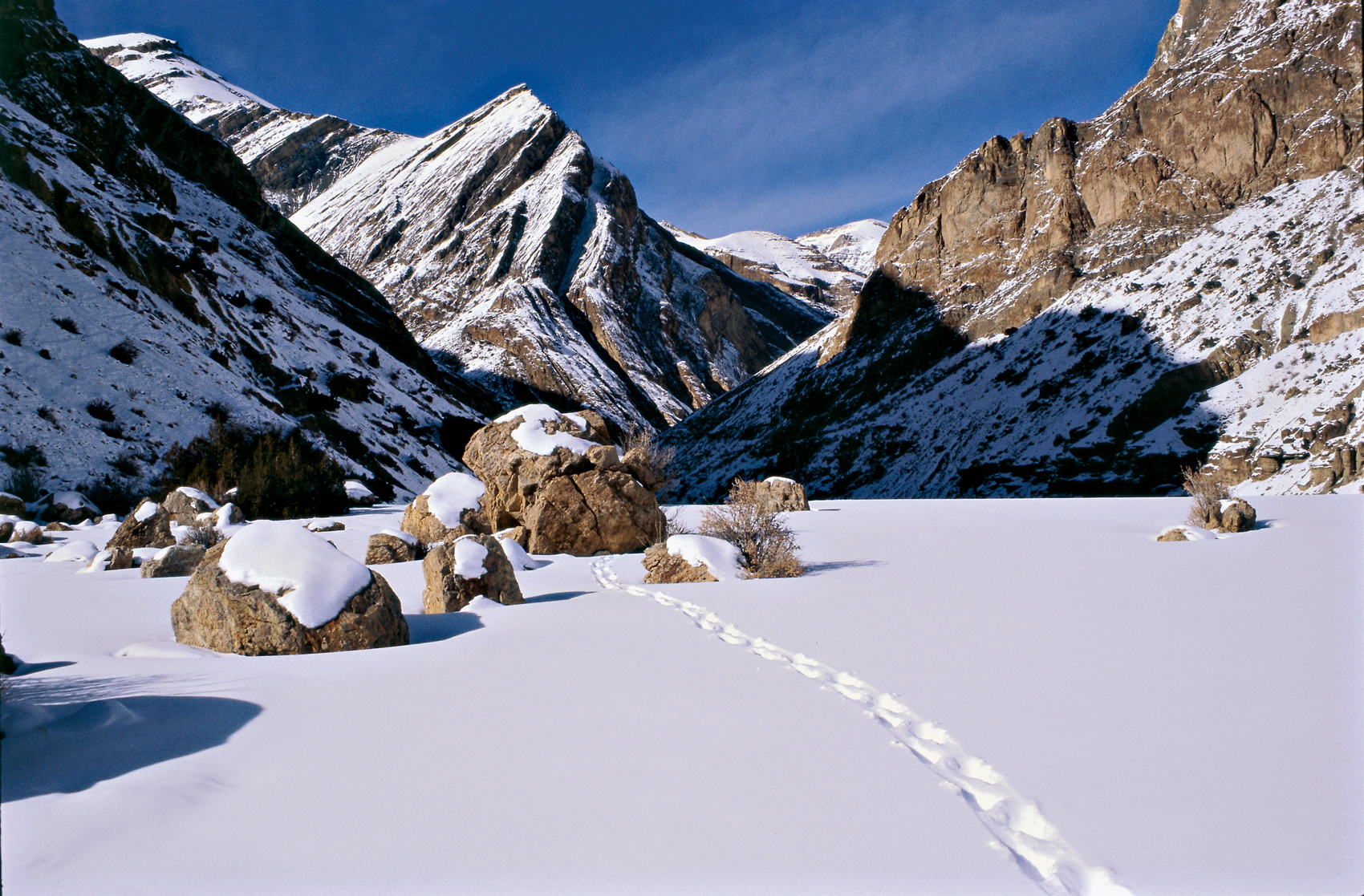
Snow leopard tracks on the ice-sheet over the Tsarab river. Zangskar also harbours species such as the wolf, wild dog, lynx, fox, brown bear, marmot and hare.
The Shun gorge
After this brief sojourn, we set out on the final leg to Shun. A strenuous tramp brought us to Sumdo, the confluence of the Tsarab river and the Shade stream, where we pitched our tent on frozen ground. The porters lit a fire under a gigantic rock, which acted as a heat reflector, and we spent the cold night huddled around it. Next morning, after a frugal breakfast of noodle soup we set out. Ashley, Dorjey, our guide and I walked on the summer trail to look for snow leopard tracks, while the porters and the cook continued their ‘penguin walk’ on the frozen river. We saw several fresh snow leopard tracks and new scratch marks on the trunk of a juniper. Always full of hope, we continued to scan the entire area for a glimpse of the mighty cat.
That day we tramped through a niveous valley for almost 12 hours, our most arduous trek thus far. My shoulders were numb with the weight on my back, and my body became clammy with sweat as I ploughed through knee-deep snow. Parched and famished, we reached Marshun at nine p.m. The village contains all of three houses and is one of just two villages in the Shun gorge.
The next morning we met the generous and open-hearted villagers, with whom we were soon on excellent terms. Largely isolated, they nonetheless looked happier than the people in Padum. Until 1980, when the road from Kargil to Padum was built, the Zangskaris lived in almost complete self-sufficiency. It was only after 1980 that trade with the outside world commenced.
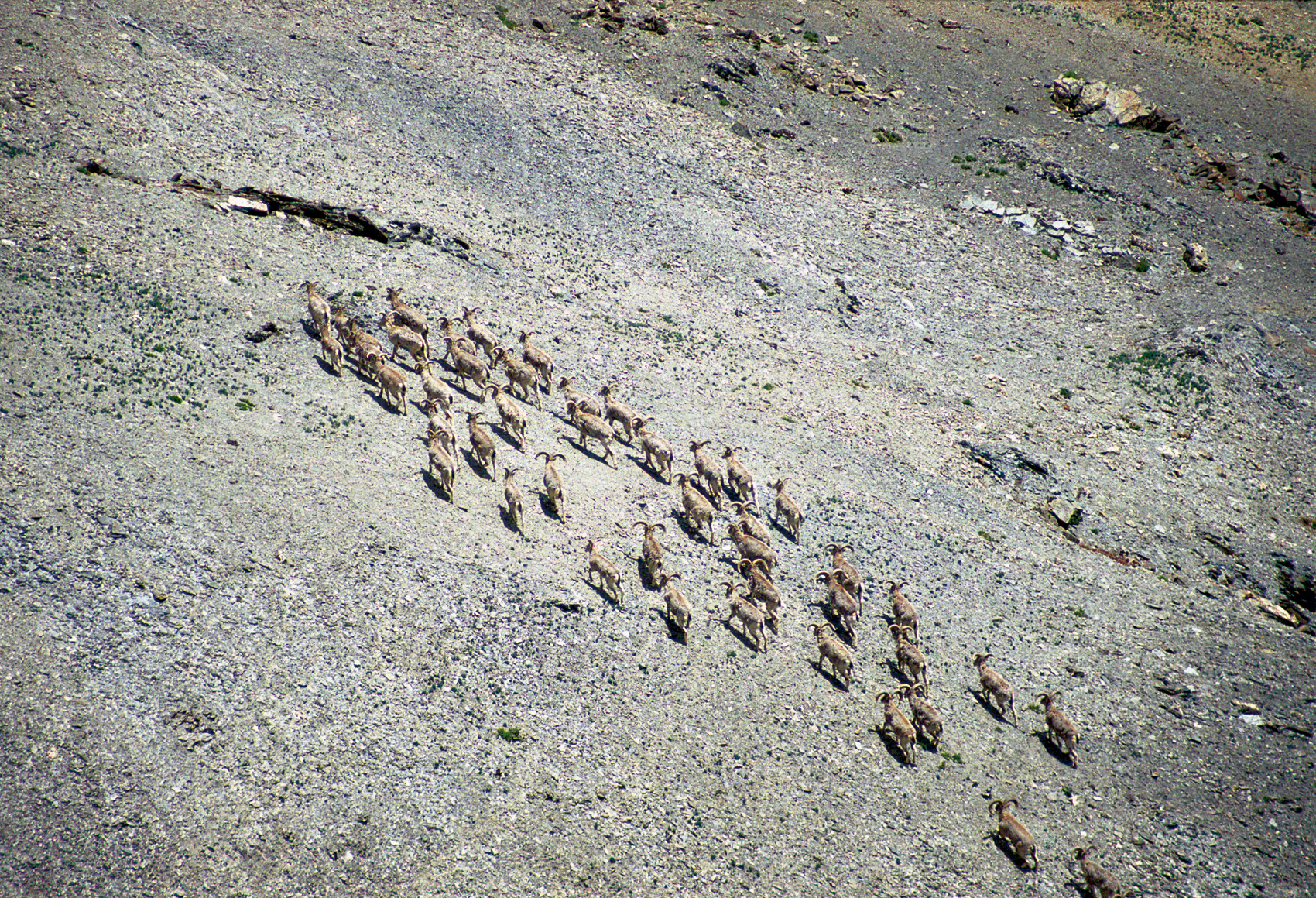
A herd of bharal rams cross a slope in the Zangskar mountains. These hardy animals are superbly adapted for life in this rugged terrain, utilising vertical cliffs and mountain sides to escape from predators.
Ibex and bharal
We spent almost a month in the Shun gorge, observing ibex and bharal, the snow leopard’s preferred prey species. Both utilise rugged terrain to escape predators, and the possibility of competition between them is high. The Shun gorge is the easternmost boundary of ibex distribution in the Zangskar mountains. It is possible that the ibex has not spread further east due to competition with the bharal, whose distribution stretches from the Tibetan plateau to the mountains of Central Ladakh. Data collected in the area indicates that they do compete for common resources and may restrict each other’s distributions on the high range-lands of the Trans-Himalaya.
The ultimate adventure
Survey completed, it was time to return to Leh, the capital city. We had three options: retrace our path, trek across the Chhachar La (La means pass in Ladakhi) or cross the Morang La to Tsokar, a brackish lake on the Changthang plateau, and then drive on to Leh. The last route was the shortest but most dangerous, as it traversed avalanche-prone areas. The villagers strongly suggested we avoid the Morang La route, and instead cross Chharchar La, a 15-day trek. Ashley, however, needed to catch a flight within two weeks, so we opted to cross the 5,300 m. Morang La. No one had done it in late winter, when the avalanche hazard is high.
Having made all our preparations, we set out with five porters and the cook. The whole village congregated in front of the house of Jorgais, the expedition leader. His wife came out with a pail of smouldering juniper twigs to pacify the mountain gods. Enveloped by the stifling grey fumes, we were then offered chhang, local barley-beer. We said our goodbyes and were off. We needed to cross the pass as soon as possible, hopefully before any further snowfall, as that would increase the avalanche hazard. After Sathak, we slowed to a snail’s pace because of the deep snow. We took turns being the ‘plough’, cutting through the snow at the head of the group.
Dazzling white snow and dark blue sky, that was all we could see. Walking in deep snow at such a high altitude might look pretty on television, but it is exhausting and dangerous. We had to rest every ten minutes. Were we foolishly defying nature? Should we have listened to the villagers? These questions flitted about my mind as I floundered through the snow. After three days of constant struggle in a never-ending world of snow and rock, we finally arrived at the base of the Morang La, which gracefully rose up into the evening sky. The next day we scrambled out of our grotto-shelter early, so that we could walk on the stiffened snow-crest before the sun warmed it. The walk was dangerous and even a small mistake could prove fatal. We were fortunate to find a column of hardened snow on a previous avalanche site, and climbed up along it, making it to the top of Morang La without any incident. A breathtaking panorama opened out before us; a sea of snowy mountain-peaks, spreading as far as the eye could see.
The vast mountains seemed deceptively lifeless, but a close look would have revealed hundreds of shining eyes and flicking tails. Besides snow leopard, ibex and bharal, Zangskar harbours species such as the wolf, wild dog, lynx, fox, brown bear, marmot and hare. Descending the pass on the other side was more difficult than expected. At some places, the snow was so deep that we got stuck, and needed to roll down rather than walk! The porters seemed as cheerful as ever, but Ashley and I were at our physical limits.
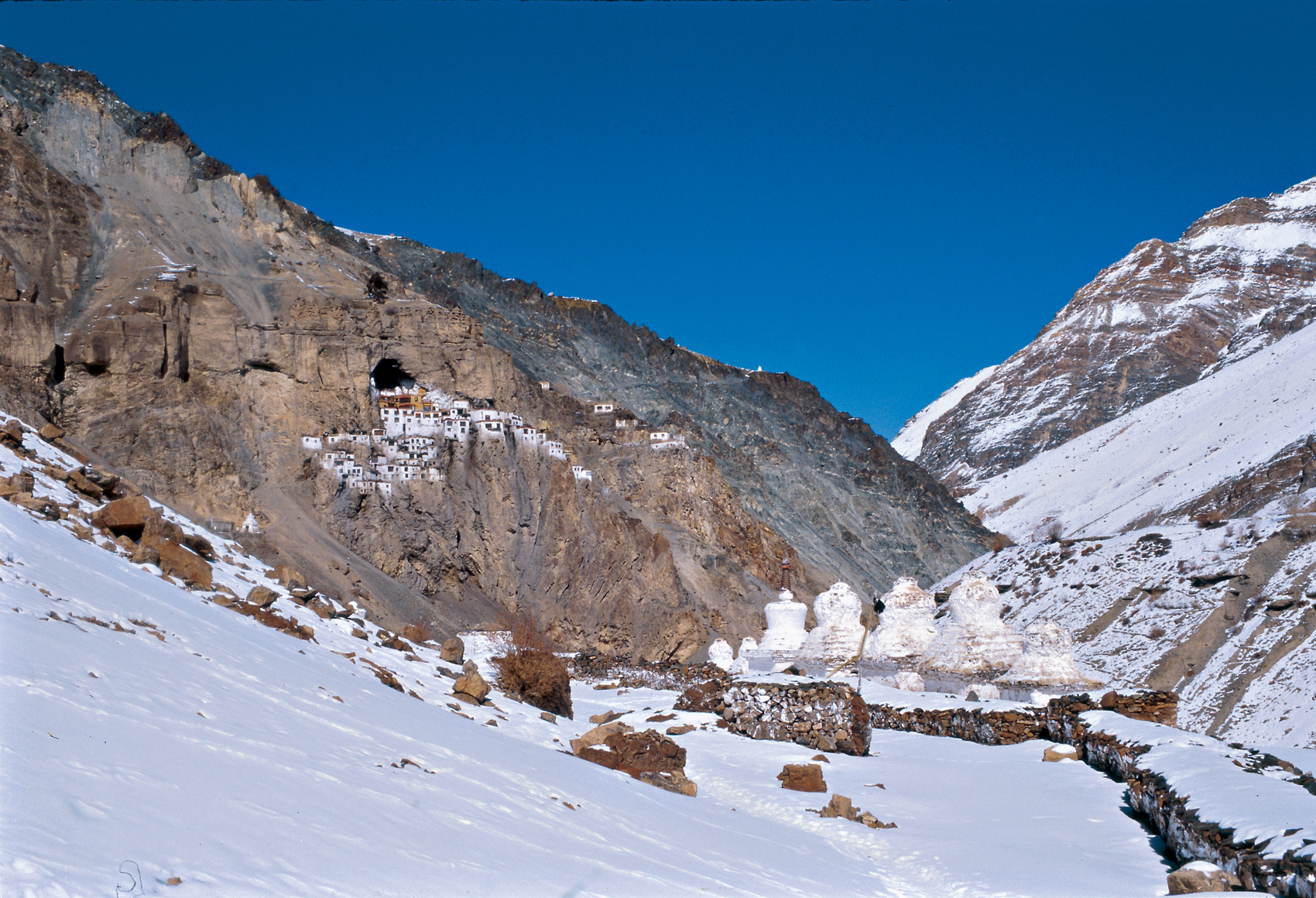
The famous Phugtal monastery in the Tsarab valley.
The Changthang plateau
In the next few days, we crossed low passes, rivers and wide valleys until we at last reached Sangtha, a Changpa nomad camp at the western edge of the windswept plateau of eastern Ladakh. Our arrival was announced by the barking of two fierce Tibetan mastiffs. We hired a horse in Sangtha and headed for Tsokar. An hour into the journey, the horse suddenly decided to gallop around in a circle, our gear on its back. The horse handler ascribed this to an angry mountain spirit! The ‘spirit’ was soon pacified however, and we resumed our journey. As night approached, however, our horseman suddenly decided to turn back. Unprepared, we had no choice but to stow our gear on the plateau and walk the remaining 10 km. to Tsokar.
At midnight, we reached Pongonagu, a nomadic camp at the western edge of the lake basin. We pitched our tent in the howling wind and slept off the tiredness and frustration. At the break of dawn, I awoke with cold feet, and noticed that the mercury had plunged down to –270C. A hot noodle soup got us back on the trail to Thugje, a settlement at the rim of the lake, where we spent the day waiting for the people who had gone to fetch our gear. Towards evening we left for Chumathang. The next day, as we drove to Leh, I was lost in nostalgic memories of Zangskar. Falling into a satisfied sleep, I only awoke to the drone and honk of Leh’s traffic.
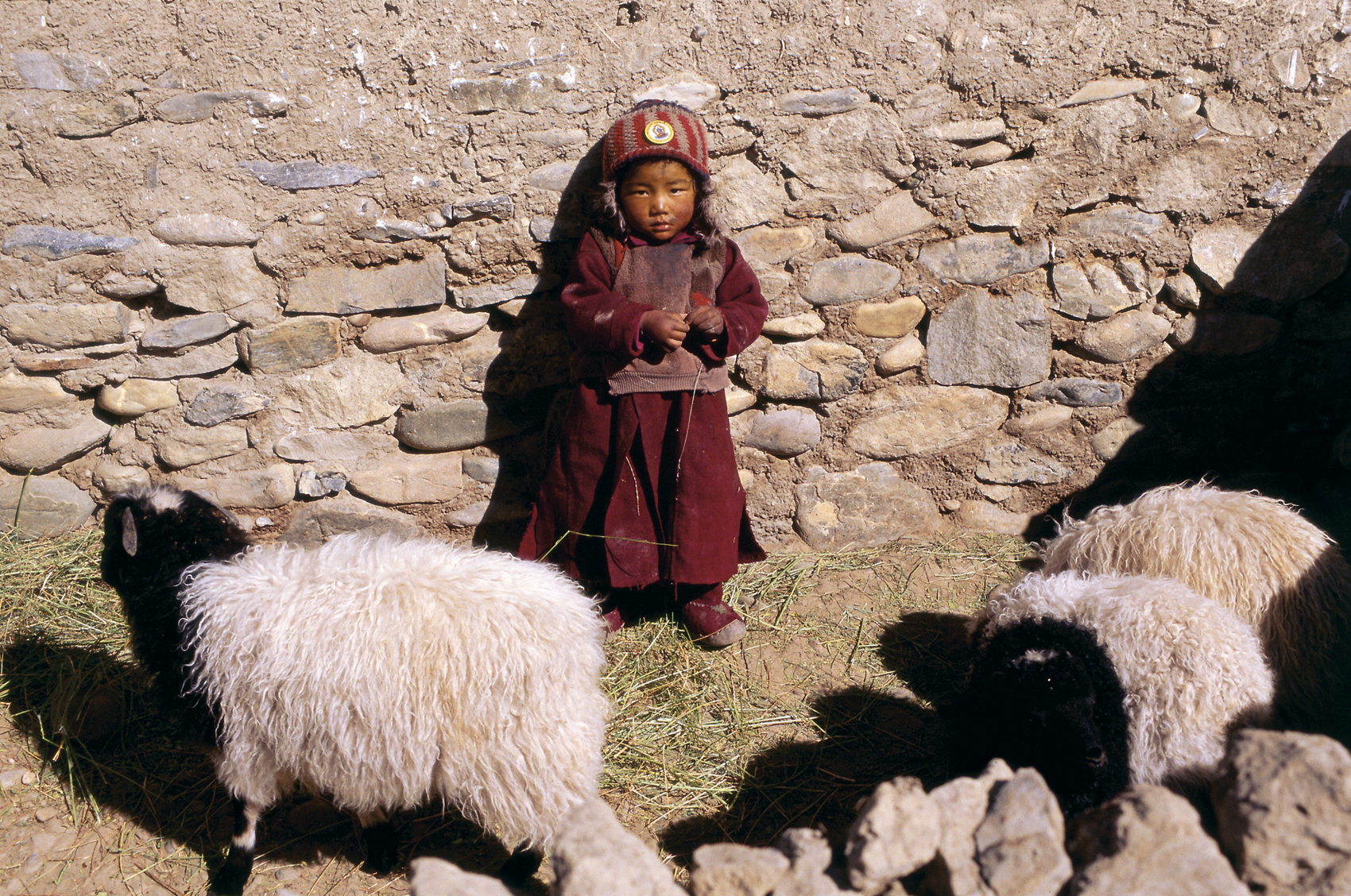
A Zangskari child watches over sheep in a corral in Yarshun village, Shun gorge.
The icy wilderness of the Zangskar mountains is a truly mystical land, one where despite all odds, the snow leopard, ibex, bharal, fox and lynx continue to cling on to survival in a seemingly barren and austere environment. It is a place where ancient traditions and religious restrictions have ensured that most people continue to live in harmony with nature. The Zangskaris surely have much to teach the rest of the world…







